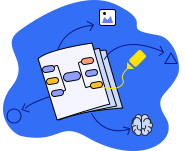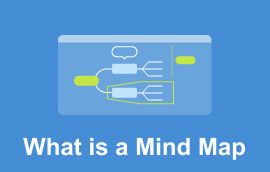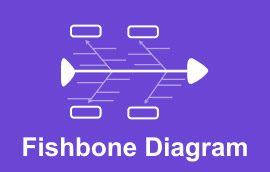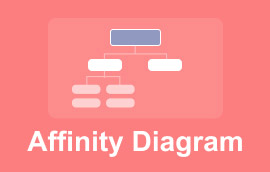What is a Plot Chart? Check All the Inclusive Information
Have you ever wondered how your favorite stories are created? What makes them so captivating? Well, the secret lies in something called a plot diagram. Worry not, for it's not as complicated as it sounds. In simple words, it is a roadmap for a story, guiding it from the beginning to the end. A plot chart diagram helps writers and readers to make stories more meaningful and enjoyable. Now, in this post, we will delve into its definition, uses, and different types. Also, discover the best way to create a personalized plot diagram.

- Part 1. What is a Plot Diagram?
- Part 2. Uses of Plot Diagram
- Part 3. Types of Plot Diagrams
- Part 4. How to Do A Plot Diagram
- Part 5. FAQs About What is Plot Diagram
Part 1. What is a Plot Diagram?
What is a plot diagram? A plot diagram is a visual presentation of the structure of a narrative. It is usually used in literature and storytelling. It also consists of labeled boxes or nodes charting key events and elements of a story in sequence. Its basic components are the exposition, rising action, climax, falling action, and resolution. By mapping out these elements, it will be helpful for both readers and writers. It will be easier to comprehend and analyze the organization and progression of a story. Thus making it a valuable way for both literary analysis and storytelling.
Part 2. Uses of Plot Diagram
Storytelling and Writing
One of the main uses of a plot diagram is in storytelling and writing. It serves as a visual representation of the story's structure. At the same time, it helps authors plan their narratives. By plotting out the components, writers can ensure that their stories are engaging and cohesive. This tool guides them in creating well-structured and captivating narratives.
Literary Analysis
In literary analysis, a plot diagram is also a valuable tool for students and scholars. It allows them to dissect and understand the fundamental structure of a story. Analyzing the diagram aids in understanding the author's intentions, themes, and character development. It also helps in identifying key plot points, such as the climax and resolution, and more. Through this, readers gain a deeper appreciation of the text's complexities and sophistication.
Teaching and Education
Plot diagrams are also used in educational settings, particularly in literature classes. Teachers use them as teaching aids to help students understand the stories they read. With plot diagrams, students learn to identify and analyze story elements. Additionally, this visual representation makes it easier for educators to discuss literary concepts.
Video Game Design
Plot diagrams are not limited to traditional storytelling. They are also utilized in video game design. Game designers use them to create a story for video games. This structure helps in designing game levels, quests, and more.
Marketing and Content Creation
Companies can adapt plot diagrams for marketing purposes and content creation. Marketers also use storytelling to engage their audience. Thus, plot diagrams assist them in creating marketing campaigns or brand narratives. Also, content creators can use it to enhance their content's engagement and make it memorable.
Part 3. Types of Plot Diagram
1. Linear Plot Diagram
A linear plot diagram is the most straightforward type. It represents a story with a clear beginning, middle, and end. It is also like following a straight path from start to finish. This type is used for simple narratives. Also, it helps readers see the story's progression in a straightforward manner.
2. Inverted Plot Diagram
In an inverted plot diagram, the story starts at a critical point or climax. Then, it unfolds, revealing how the characters reached that moment. Think of it as beginning with the most exciting part. Afterward, you’ll look back to see how it all came together. This type is often used to create suspense and intrigue.
3. Circular Plot Diagram
A circular plot diagram, as the name suggests, is shaped like a circle. It represents a story where the ending connects back to the beginning in some way. It's like going on a journey that brings you full circle. This type can symbolize cycles, repetition, or the idea that history repeats itself.
4. Pyramid Plot Diagram
In a pyramid plot diagram, the story's tension and conflict build steadily towards a single climax. Then, it creates a sense of rising action and intensity. It is a type of plot often used for dramatic and suspenseful stories.
5. Episodic Plot Diagram
In episodic narratives, the story is divided into separate episodes or chapters. Each with its own plot structure. An episodic plot diagram helps readers see the distinct arcs within each episode. At the same time, understanding the overall story's structure. It's like a series of connected short stories within a larger narrative.
Part 4. How to Do A Plot Diagram
MindOnMap is a versatile mind-mapping tool that facilitates the creation of plot diagrams. Not only that, but also other visual representations of ideas and concepts. With it, you can craft a plot diagram to map out the key elements and structure of a story. It also provides several elements you can add to your diagram. You can choose and add shapes, text, lines, and more. Further, you can personalize your diagram with various colors, styles, and fonts. Moreover, it supports collaboration. So, it is suitable for group projects or working with editors and colleagues. While also enabling real-time collaboration and feedback.
MindOnMap is a web-based diagram maker. You can access it on various browsers such as Google Chrome, Safari, Edge, and so on. So, as long as you have an internet connection, you can create a diagram from any device. Yet, if you want an offline version of it, use its app version by downloading it on your computer. To add to its notable features, MindOnMap has an auto-saving feature. Whatever changes you make to your work, the tool will save it immediately. Thus preventing any data loss. All in all, MindOnMap simplifies the process of creating plot diagrams. It is indeed an excellent choice for writers, students, and anyone interested in visually organizing storytelling elements. To know how you can create a plot diagram with it, follow the guide below.
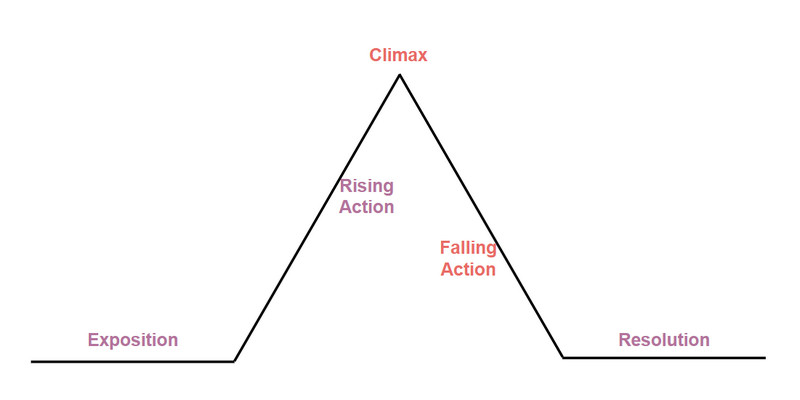
Access the Web-Based Tool or Download
To get started, launch your preferred browser and visit the official MindOnMap website. Then, click on either the Free Download or Create Online button. To gain full access to the platform's features, sign up for an account. After that, you'll be directed to the main interface of the program.
Secure Download
Secure Download
Choose a Layout
On the main interface, you'll find various layout options. For this tutorial, we'll select the Flow Chart layout, which is ideal for creating a plot diagram.
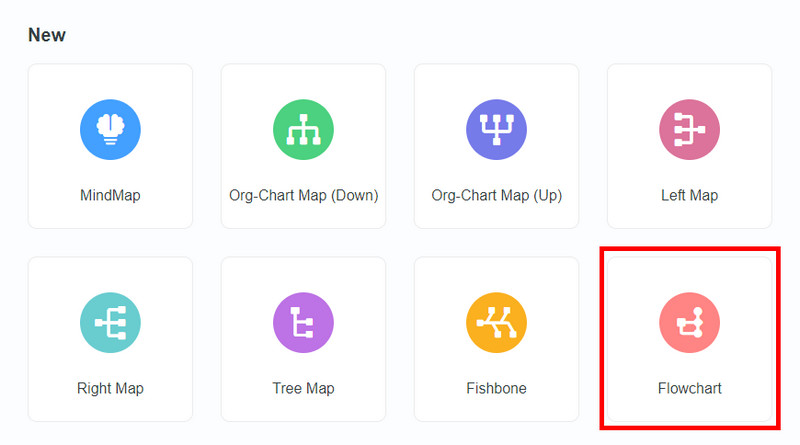
Customize Your Plot Diagram
On the left side of your current window, you'll find a selection of shapes that you can use. Add lines, shapes, text, and other elements to showcase the components of your plot diagram.
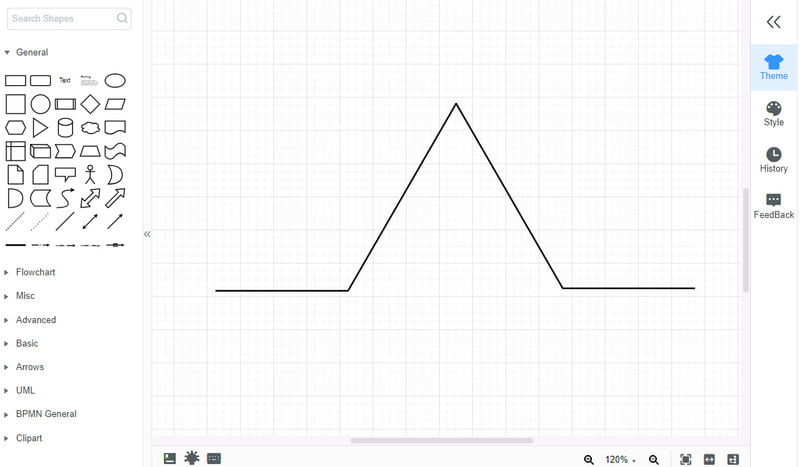
Share Your Plot Diagram
It's possible to share the timeline you've created with peers or colleagues. Click the Share button located in the upper-right corner. In the dialog box that appears, mark checkboxes for options such as Password and Valid until. This way, you’ll enhance security and specify a validation date.
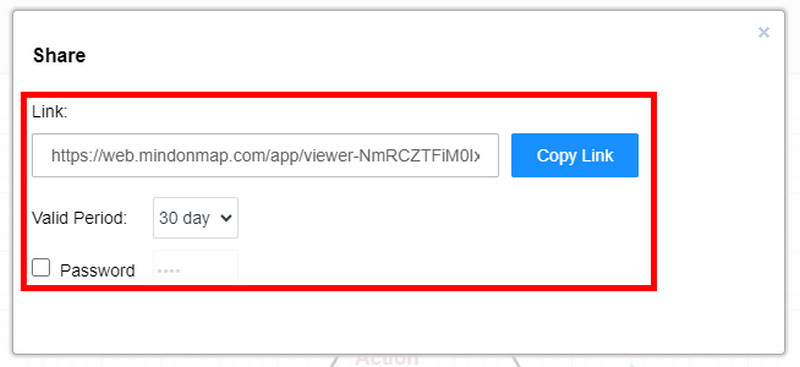
Export Your Plot Diagram
Once you've achieved the desired look and content for your diagram, it's time to save your work. Hit Export and choose your preferred file format for saving. And that’s it!
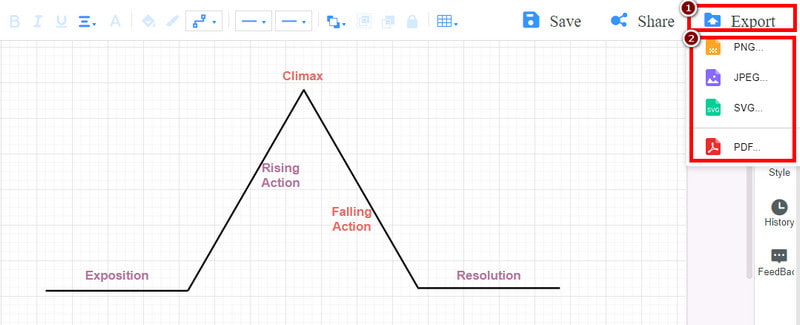
Further Reading
Part 5. FAQs About What is Plot Diagram
What are the 5 parts of a plot diagram?
The 5 parts of a plot diagram include the exposition, setting, rising action, climax, falling action, and resolution.
What are the 6 stages of a plot diagram?
The 6 stages of a plot diagram comprise the introduction, conflict, rising action, climax, falling action, and resolution, providing closure to the narrative.
What are the 5 elements of the plot in order?
The 5 elements of the plot consist of the exposition, rising action, climax, falling action, and resolution, collectively forming the structure of a narrative.
Conclusion
The plot diagram is the skeleton upon which compelling narratives are built. Its significance extends to literary analysis, writing, and even visual media production. In this modern age, tools like MindOnMap provide a modern and user-friendly means to construct and visualize these crucial storytelling aids. If you're studying a classic book, making up your own story, or planning any creative project, knowing how to use a plot diagram, especially with digital tools like MindOnMap, can make you better at storytelling and help you enjoy stories more. It's like having a map to explore and understand the exciting stories that capture our imagination.








